For the final a number of days, I’ve been operating on considered one of my puppy initiatives for my portfolio. To be actual, I’ve been developing an analytical dashboard for an airline corporate. Discovering appropriate gear became out to be a problem. I sought after to make use of Subsequent.js within the stack, and my purpose was once to ensure any consumer may just perceive the introduced statistical knowledge and, secondly, interactively discover the tips. So, on this educational, I can minimize my method via setting up the dashboard and making a pivot desk and charts within the Subsequent.js app at the instance of an airline corporate. With a bit of luck, it is going to prevent time 🙂
Necessities
Right here, I want to percentage the entire issues I did to arrange for developing the crucial statistics. And we can get started with…
Examining the Topic House
As a base, we can use a loose, out there dataset on landings of a significant airport in the US — San Francisco World Airport.
In the beginning, we need to analyze the topic house and perceive what insights we’re in search of. Allow us to consider ourselves as airport executives. We’ve got loads of arrivals and departures of various varieties, scales, airways, and many others. What can we most probably need to be told? The potency of our status quo certainly. So, I decided on some lead facets for this box:
- touchdown frequency,
- touchdown time,
- plane producer fashions in use,
- flight geography,
- landed weight.
Ultimate Dashboard
As we get via this educational, we can steadily create an interactive dashboard and, extra importantly, learn how to create it with Subsequent.js. Our completed web page will include a pivot desk and various other charts.
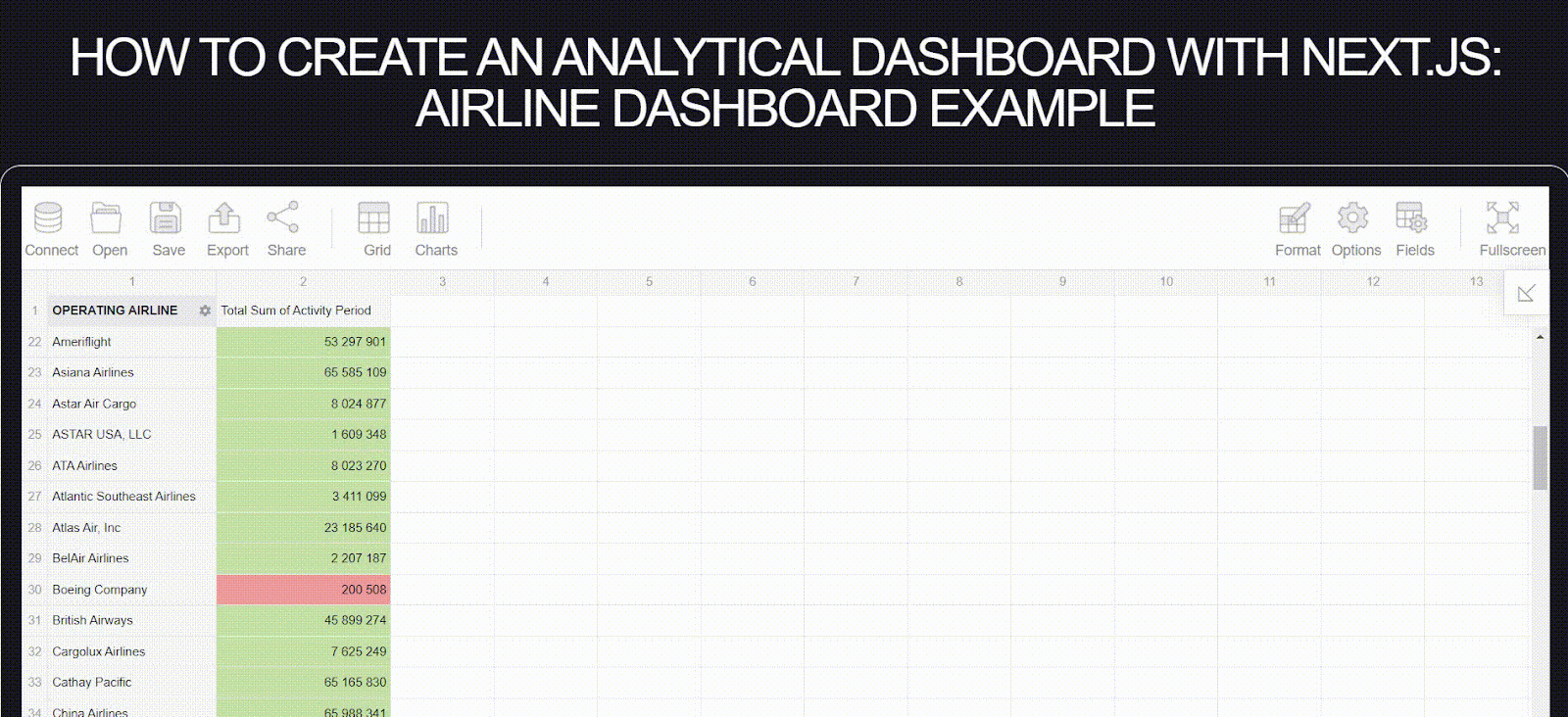
Equipment
A lot of knowledge calls for tough manner to show it. So, I surfed the Web and after all targeted at the most fitted ones for my wishes. I created a pivot desk with Flexmonster and charts with Highcharts. Fortunately, those two libraries are tremendous user-friendly, customizable, fine-integrated with every different, and, extra importantly, well-deployed on Subsequent.js.
Via the way in which, this newsletter on the most productive gear for reporting in React was once in reality useful in making my selection.
Now, let’s dive into the combination procedure.
Connecting Highcharts and Flexmonster to the Subsequent.js App
It’s time to determine the best way to release those cool shapes and tables at the laptop. So:
1. Set up Flexmonster CLI
npm set up -g flexmonster-cli
npm set up highcharts highcharts-react-official2. Open your Subsequent.js assignment or create it via operating two traces
npx create-next-app flexmonster-project --ts --app
cd flexmonster-project3. Get the Flexmonster wrapper for React:
flexmonster upload react-flexmonsterWere given it! Because you set up libraries, let’s transfer additional, embedding them into the assignment.
4. Import Flexmonster to international.css:
@import "flexmonster/flexmonster.css";5. Create a separate report PivotWrapper.tsx connecting Flexmonster and Highcharts as effectively. It is going to be a wrapper for our long term pivot desk:
'use shopper'
import * as React from 'react';
import * as FlexmonsterReact from "react-flexmonster";
import Flexmonster from 'flexmonster';
import "flexmonster/lib/flexmonster.highcharts.js";
// A customized kind so we will be able to move a reference in conjunction with different Flexmonster params
kind PivotProps = Flexmonster.Params & {
pivotRef?: React.ForwardedRef<FlexmonsterReact.Pivot>;
}
// The pivotRef can be utilized to get a connection with the Flexmonster example so you'll get admission to Flexmonster API.
const PivotWrapper: React.FC<PivotProps> = ({ pivotRef, ...params}) => {
go back (
<FlexmonsterReact.Pivot
{...params}
ref={pivotRef}
/>
)
}
export default PivotWrapper;6. Import the wrapper into your web page. You’ll title it to your method, however I did it in pivot-table-demo/web page.tsx:
"use shopper"
import * as React from "react";
import kind { Pivot } from "react-flexmonster";
import dynamic from "subsequent/dynamic";
import * as Highcharts from 'highcharts';
import HighchartsReact from 'highcharts-react-official';
// Wrapper will have to be imported dynamically in order that Flexmonster is loaded best when the web page is rendered at the shopper aspect. Be told extra about dynamic imports in Subsequent.js.
const PivotWrap = dynamic(() => import('@/app/PivotWrapper'), {
ssr: false,
loading: () => <h1>Loading Flexmonster...</h1>
});
const ForwardRefPivot = React.forwardRef<Pivot, Flexmonster.Params>((props, ref?: React.ForwardedRef<Pivot>) =>
<PivotWrap {...props} pivotRef={ref} />
)
ForwardRefPivot.displayName="ForwardRefPivot";7. Insert PivotWrapper element and Highcharts into your web page as proven beneath:
export default serve as WithHighcharts() {
const pivotRef: React.RefObject<Pivot> = React.useRef<Pivot>(null);
const reportComplete = () => {
pivotRef.present!.flexmonster.off("reportComplete", reportComplete);
//developing charts after Flexmonster example is introduced
createChart();
}
const createChart = () => {
// we can outline charts right here later
}
go back (
<div className="App">
<div identification="pivot-container" className="">
<ForwardRefPivot
ref={pivotRef}
toolbar={true}
beforetoolbarcreated={toolbar => {
toolbar.showShareReportTab = true;
}}
shareReportConnection={{
url: "https://olap.flexmonster.com:9500"
}}
width="100%"
top={600}
record = {{
dataSource: {
kind: "csv",
// trail to the dataset of San Francisco Airport Landings
filename: "https://question.knowledge.global/s/vvjzn4x5anbdunavdn6lpu6tp2sq3m?dws=00000"
}
}}
reportcomplete={reportComplete}
// insert your licenseKey beneath
licenseKey="XXXX-XXXX-XXXX-XXXX-XXXX"
/>
</div>
// we can insert charts beneath later
)
}9. Construct and run the app:
You’ll discover extra in regards to the integration of Flexmonster with Subsequent.js and Highcharts in Flexmonster documentation.
The pivot desk is able; the charts are in line!
Atmosphere Chart Configuration Up
On this educational, I take advantage of pie, bar, column, areaspline, and scatter charts. It seems like so much, however Highcharts has much more chart varieties to suggest. It’s also conceivable to customise them in your liking. Additional, I can let you know the whole chart-defining procedure for any chart and emphasize some essential issues.
1. Insert Highcharts into your web page
Now, transfer right down to the go back() phase. Right here, you describe your web page format. You’ll insert Highcharts into <div> blocks. So, create the primary one <div> block and input its `identification`. For instance, my chart tells about touchdown frequency via plane kind. So, I title it as ‘chart-frequency-aircraft’:
<div>
<p>Via Plane Kind</p>
<div className="chart" identification="chart-frequency-aircraft"></div>
</div>2. Outline the chart choices
Chart configuration will have to be initialized within the createChart() serve as. Highcharts is accessed via Flexmonster PivotWrapper, because it dynamically receives knowledge from the element. You could have created the chart container; now describe the diagram’s look. Listed below are my outlined choices for the second one pie chart on this educational:
//Working Flexmonster's getData means to supply Highcharts with aggregated knowledge
pivotRef.present!.flexmonster.highcharts?.getData(
{
kind: 'pie',
// see the checklist of varieties on Highcharts documentation: https://www.highcharts.com/medical doctors/chart-and-series-types/chart-types)
slice: {
rows: [
{
// Here you type the name of the row in dataset
uniqueName: 'Landing Aircraft Type',
},
],
measures: [
{
// Here you type the name of the row in dataset
uniqueName: 'Landing Count',
// You can use aggregation functions as well
aggregation: 'count',
},
],
},
},
(knowledge: any) => {
// Substitute ‘chart-frequency-aircraft’ with vital <div> identification for different charts
Highcharts.chart('chart-frequency-aircraft', knowledge);
},
(knowledge: any) => {
Highcharts.chart('chart-frequency-aircraft', knowledge);
}
);If you wish to customise your chart, you’ll do it via gaining access to knowledge houses inside of (knowledge: any) => {} serve as. For instance, I created an interior hollow within the pie chart to create a customized donut chart via including those traces:
(knowledge: any) => {
knowledge.plotOptions = {
pie: {
innerSize: '50%',
dataLabels: {
enabled: true,
structure: '<b>{level.title}</b>: {level.share:.1f} %',
},
},
}
Highcharts.chart('chart-frequency-aircraft', knowledge);
},Watch out! You will have to alternate knowledge prior to it passes to the Highcharts.chart() serve as as a parameter.
Different charts can also be created in a similar fashion. You’ll see extra examples at the Highcharts demo web page. You’ll additionally learn extra about other houses in its legit API documentation.
Within the following sections, we’ll pass deeper into analytics and chart selection and percentage some insights.
Working In the course of the Dashboard
We’re already conversant in the topic house, so let’s discover the dashboard deeper, bearing in mind the lead facets of the airport workflow.
Touchdown Frequency
The partnership between airports and airways is rather essential because it impacts the source of revenue of each. Working out main airways can assist servicing corporations identify trade members of the family. An airport is in a position to organize touchdown charges, its personal coverage, and so forth. If you wish to discover airport-airline members of the family extra deeply, welcome to the good article right here.
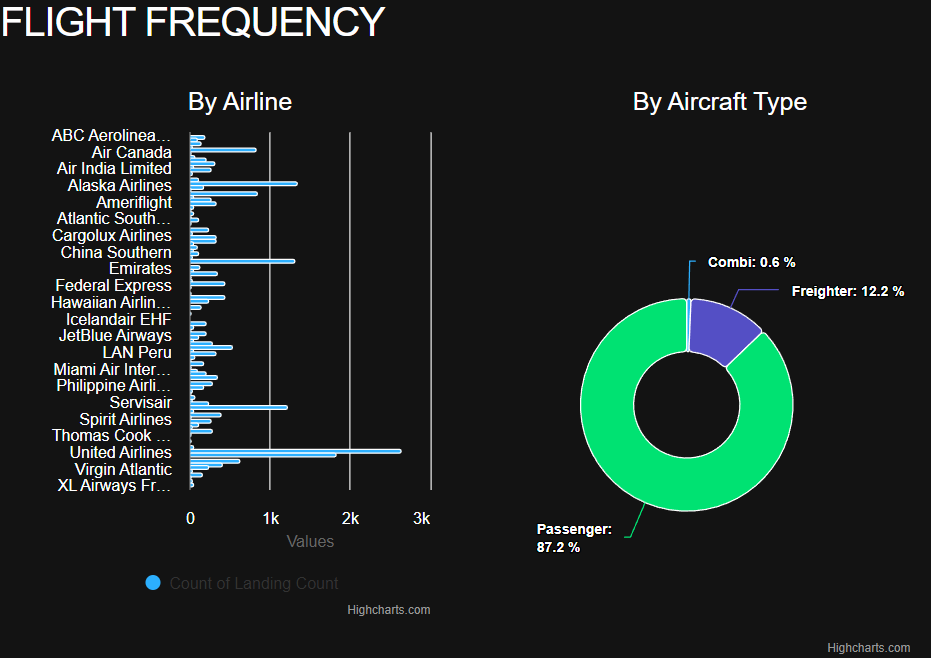
To investigate the flight frequency via airways within the airport, I selected a bar chart because it incorporates numerous contributors to turn, and I will be able to with ease evaluate the quantitative distinction. But even so the obvious domination of United Airways, we will be able to see that Emirates (Dubai) and Servisair (United Kingdom) are some of the leaders in touchdown depend.
When examining the flight frequency via plane kind, I most well-liked the donut chart since this chart very best displays the share courting. Plus, we have now best 3 contributors, so with the donut chart, it’s a lot more uncomplicated to understand how a lot passenger flights dominate over freight transportation.
Hmm, what about extra detailed analytics? Here’s a shining second of Flexmonster Pivot. Let’s briefly set it up and configure the required record!
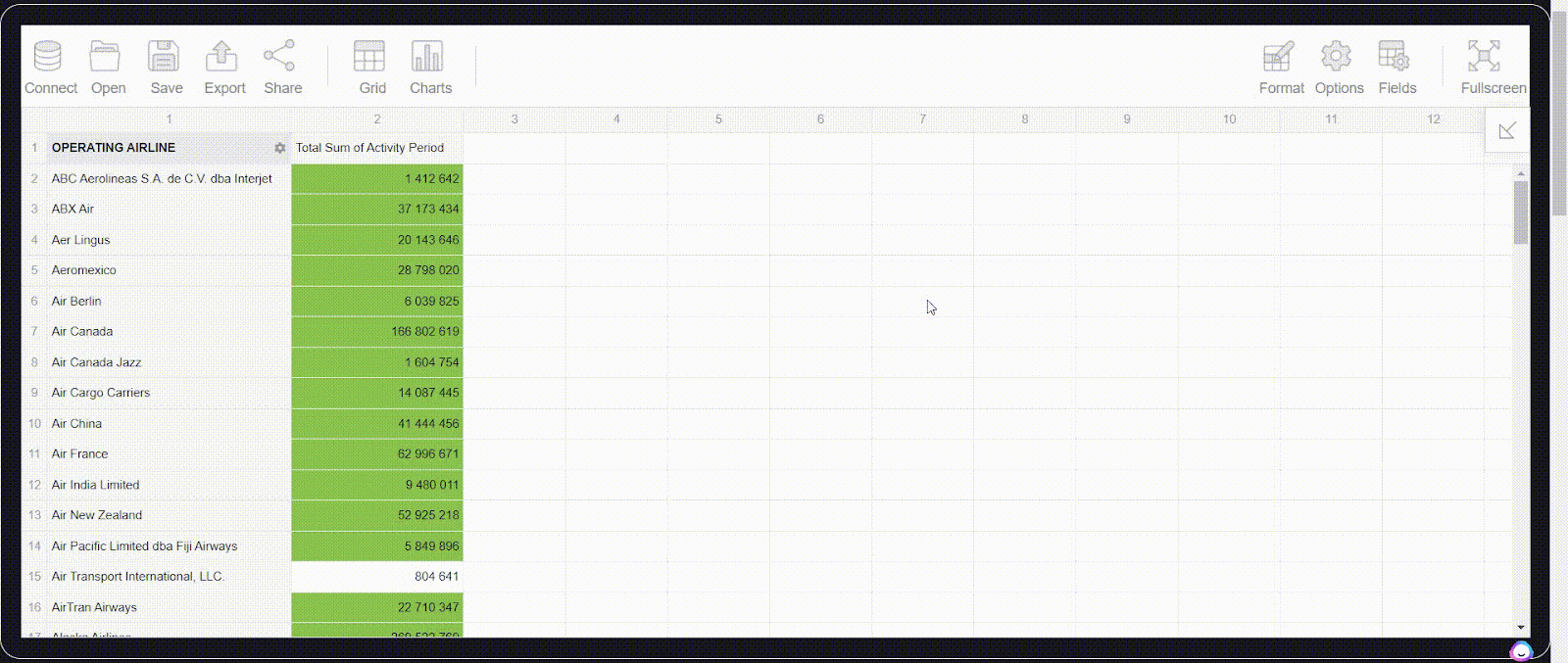
And now, we’re ready to look touchdown process via airways chronologically.
I can explain my objective. Right here, I highlighted the touchdown depend in inexperienced colour when an airline served 1 million flights or extra. If it did not up to 600k, the cellular is yellow and crimson if it did not up to 300k. The price is suitable if it levels between 600k and 1 million. From right here, I will be able to understand the best and lowest airline process classes. I did it the use of the conditional formatting characteristic constructed into the Flexmonster pivot desk. Any consumer can upload non-public stipulations, structure textual content within the cells, and set their very own knowledge look proper from the UI.
Touchdown Time
This analytics discovers members of the family between landings depend and both yr shift or month shift. First, we see how the landings depend adjustments from yr to yr. Via deciding on various kinds of plane our bodies at the column chart, we will be able to see the dynamic of landings and review every worth via yr.
Zooming out and in, we will be able to see that passenger transportation is continuously rising whilst shipment and blended shipping are shedding their relevance.

How does jet process alternate right through every yr? Differently to show worth shifts right through a yr is to make use of areaspline chart. I will be able to follow how other classes take their percentage within the general touchdown depend. Clearly, the process top is in February and March.
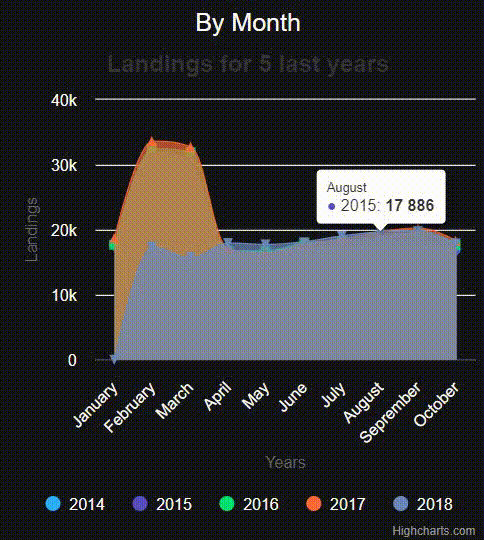
Plane Producer Fashions in Use
An airport will have to be conversant in the specifics of the cars it really works with as they are able to want some carrier whilst ready within the terminal. The next chart presentations the distribution of plane producers in San Francisco airport operations. Since I decided on the pie chart, it’s transparent to note Boeing’s and Airbus’s dominance in comparison to others. Listed below are some smaller manufacturers, like Bombardier, Embraer, and McDonell Douglas.

I additionally analyzed those statistics dynamically in Flexmonster Pivot. For this objective, I decided on some comparable fields within the pivot desk. Right here, I will be able to kind alphabetically A-Z. As well as, I switched to “Charts” mode and easily inspected producer distribution via plane frame kind. Highcharts supplies cool interactive charts, whilst Flexmonster means that you can configure new slices and alter visualizations proper at the fly.

Flight Geography
Right here, we check out the geography of flights to identify which flight instructions are extra related for this airport. Over part of the flights attach the airport with Asian nations, and some other quarter with Ecu ones.

Landed Weight
The final side is the landed weight. In the beginning, we read about values via every month of all of the duration of observations. Notice that dates are equipped within the structure “YYYYMM” within the dataset, so they’re introduced the similar method at the horizontal axis within the visualization. I need to see the form of the values shift, so I selected a line chart for it. It’s extra concise than a column chart once we paintings with numerous knowledge. So, we see how the touchdown depend modified from 2005 to 2018 and spot winning and damaging months.
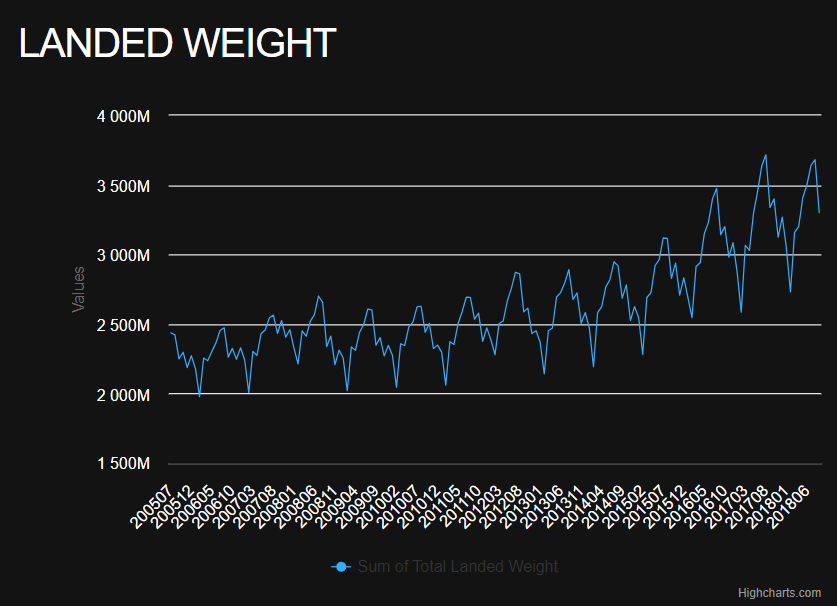
Every other statistic is rather unique. This is a correlation (i.e., the energy of the connection) between landed weight and touchdown depend. This worth levels from -1 to at least one. The nearer it’s to at least one, the extra one worth will depend on some other. In the end, the final chart tells us the flight potency dynamic yr via yr.

Complete Demo Hyperlink
You’ll take a look at the total Subsequent.js demo app and discover the dashboard your self on my GitHub.
Ultimate Phrases
On this educational, we have now created an interactive statistical dashboard, analyzed the paintings topic, and processed the dataset. We’ve got additionally spotted some specifics in configuring Highcharts and dealing with the Flexmonster desk. Don’t overlook that so as to use the total doable of those parts.
To sum it up, I in reality loved composing analytics within the box of flights. Its knowledge seems to constitute quite a lot of flexible options. Moreover, I used to be shocked via the loss of suitable tutorials on Subsequent.js. So, I did this newsletter and hope it is going to mean you can percentage analytical knowledge simply. I want you just right good fortune to your long term seek!